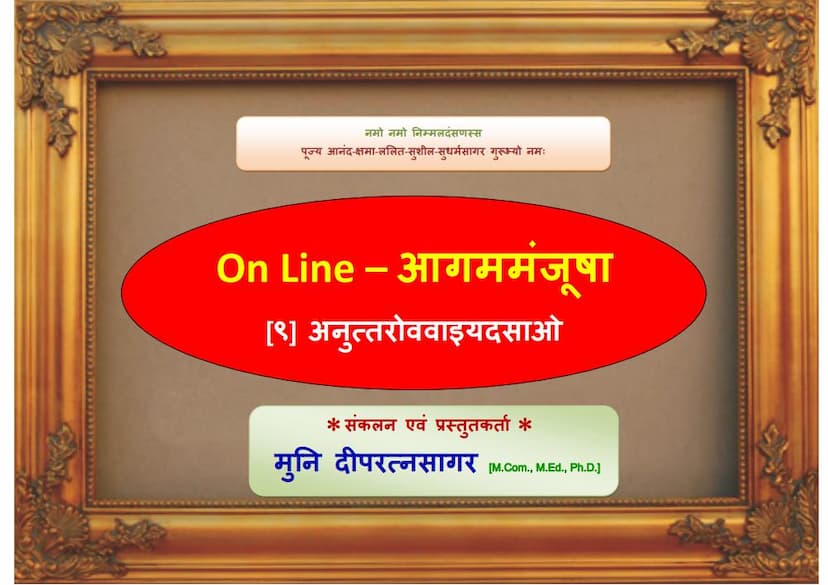Aagam Manjusha 09 Angsuttam Mool 09 Anuttarovvaaiya
Added to library: September 1, 2025

Summary
Here's a comprehensive summary of the provided Jain text, "Anuttarovavaiya Dasao," which is the ninth Anga Sutra within the Agam Manjusha series:
Book Title: Aagam Manjusha 09 Angsuttam Mool 09 Anuttarovvaaiya Author(s): Anandsagarsuri, Sagaranandsuri Publisher: Deepratnasagar
Overall Context:
This document is an online presentation of the "Anuttarovavaiya Dasao" (also transliterated as Anuttaraupapātikadaśā), the ninth Anga (principal scripture) of the Jain Agamas. It's presented as part of the "Aagam Manjusha" series, which was originally compiled and edited about 70 years prior to the online edition's date (2012). The online version aims to provide the original text along with some modifications and additions to make it accessible online. The document details specific sutras (verses or chapters) and their meanings, focusing on the lives and spiritual journeys of individuals who attained the highest states of existence (Anuttara Saudharmaka).
Key Points and Structure:
The text is structured around the "Anuttarovavaiya Dasao" and is divided into sections, primarily focusing on different "vargas" (classes or groups) within the scripture. The presentation includes:
-
Introduction (Page 2):
- It highlights that the "Aagam Manjusha" was first compiled by Acharya Shri Anand Sagar Suriji in 1942 (Veer Samvat 2468).
- The current online version (2012, Veer Samvat 2538) is a faithful reproduction with some updates for online accessibility.
- It mentions slight variations in the original compilation, including the inclusion of Niryukti (commentary on roots) for Aavashyak Sutra, Bhashya (exposition) for Jita Kalpa Sutra, and its alternate Pancha Kalpa, as well as the inclusion of Pind Niryukti.
- The contact information for Muni Deepratnasagar, the presenter of the online version, is provided.
-
Content of Anuttarovavaiya Dasao (Pages 3-6):
- Initial Section (Page 3):
- The text begins with a narrative setup, describing the presence of Lord Mahavir in Rajagriha and a gathering of his disciples.
- It clarifies that the "Anuttarovavaiya Dasao" is the ninth Anga.
- First Varga (First Class): This varga contains ten chapters. The text then details the first chapter, focusing on Jali Kumar.
- It recounts Jali Kumar's renunciation after hearing Lord Mahavir's discourse, his ascetic practices for sixteen years, and his subsequent rebirth in the highest heaven (Alakachitta, Ishana, etc., and finally in Vijay Viman).
- The text elaborates on his lifespan in that divine realm (32 Sagaropama) and his eventual liberation in Mahavideha Kshetra.
- The narrative emphasizes the teachings related to Jali Kumar's asceticism and his spiritual progress.
- The text then moves to describe the second varga, which contains thirteen chapters. It names the individuals covered in these chapters, such as Deehadatta, Mahasena, etc.
- Second Varga (Page 4):
- This section focuses on the first chapter of the second varga, detailing the life of Deehadatta Kumar.
- Similar to Jali Kumar, the narrative outlines his renunciation, ascetic practices, and rebirth in higher heavens.
- It emphasizes the duration of his penance (sixteen years) and his eventual attainment of liberation.
- The text provides specific details about the names of the individuals and their respective penances and destinations.
- Third Varga (Pages 4-6):
- This section covers the third varga, which contains ten chapters. It lists the individuals, starting with Dhanne and Sunakshatra.
- The detailed narrative focuses on Dhanne Anagar (ascetic):
- His background as the son of a wealthy merchant in Kākandi city.
- His renunciation and ascetic practices.
- The text vividly describes Dhanne's emaciated physical state due to severe austerities, using extensive similes to illustrate his dried-up body, bones, skin, limbs, etc. This detailed description highlights the extreme nature of his penance.
- The narrative recounts how King Shrenika of Rajagriha questioned Lord Mahavir about who among his disciples performed the most arduous penance. Lord Mahavir identified Dhanne Anagar as the one.
- The text then describes the king's reverence for Dhanne and his subsequent realization of the profound spiritual attainment.
- Dhanne's ultimate fate is described: rebirth in higher heavens (Sarvasiddha Viman) with a lifespan of thirty-three Sagaropama, and eventual liberation in Mahavideha Kshetra.
- Following Dhanne, the text briefly covers Sunakshatra Anagar:
- His similar background as the son of a merchant in Kākandi.
- His renunciation and severe austerities.
- His rebirth in a higher heaven (Sarvasiddha Viman) with a lifespan of twenty-nine Sagaropama and eventual liberation.
- The text indicates that the remaining eight chapters of this varga follow a similar pattern, with each individual undergoing extreme penance and achieving liberation. It lists some of the locations associated with these individuals (Rajagriha, Vanaragrama, etc.).
- Initial Section (Page 3):
-
Concluding Remarks:
- The text concludes by stating that the entire ninth Anga, "Anuttarovavaiya Dasao," comprises three vargas (classes) with a total of 33 chapters (10 in the first, 13 in the second, and 10 in the third).
- It reaffirms that these narratives are told by Lord Mahavir, the Tirthankar, and describe individuals who have attained the highest state of existence.
- The inscription details mention the engraving at Shri Vardhaman Jain Aagam Mandir on Vaishakh Krishna Tritiya in Veer Samvat 2468.
Significance of "Anuttarovavaiya Dasao":
This scripture is significant for detailing the lives of individuals who, through intense asceticism and adherence to Jain principles, transcended the cycle of birth and death to reach the highest realms of existence. The text emphasizes the power of tapa (austerities) and sanyama (self-control) in achieving spiritual liberation. The vivid descriptions of Dhanne Anagar's physical deterioration due to his penances serve as a powerful testament to the dedication required for such spiritual pursuits in Jainism. The "Anuttara" (supreme) in the title refers to the highest heavens, where these beings reside before their final liberation.